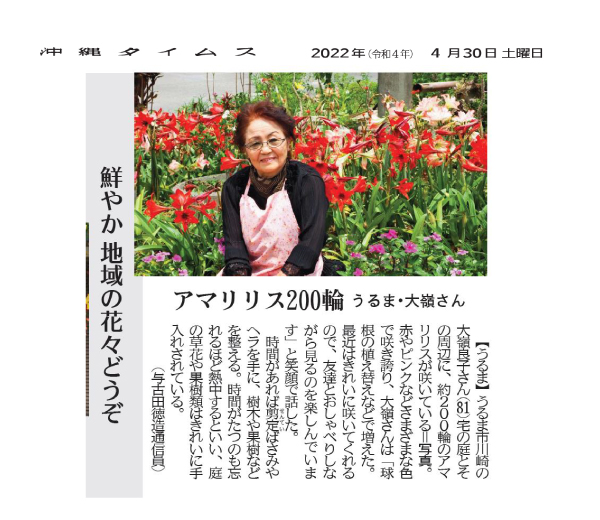Dr.Teruo Higa’s
Living A Dream
- 2025
- Apr:#204 How EM Use Has Spread Throughout the Philippines
- Mar:#203 How to Use EM to Fundamentally Solve the Problem of Agricultural Residue Burning
- Feb:#202 The Spread of EM technology in Germany
- Jan:#201 The 2nd Ichiro Masaki Memorial Universal Village EM International Conference
- Jan:#200 Cleanup of the Ala Wai Canal in Hawaii, where social bonds are strengthened using EM
- 2024
- Nov:#199 EM trials in India with bananas, tomatoes, and pomegranates
- Oct:#198 The Steadily Evolving EM Nature Farming Method at the Blue Sky Palace - Part 8
- Sep:#197 The Steadily Evolving EM Nature Farming Method at the Blue Sky Palace - Part 7
- Aug:#196 The Steadily Evolving EM Nature Farming Method at the Blue Sky Palace - Part 6
- Jul:#195 The Steadily Evolving EM Nature Farming Method at the Blue Sky Palace - Part 5
- Jun:#194 Steadily Evolving EM Nature Farming Method at the Blue Sky Palace - Part 4
- May:#193 Steadily Evolving EM Nature Farming Method at the Blue Sky Palace - Part 3
- May:#192 Steadily Evolving EM Nature Farming Method at the Blue Sky Palace - Part 2
- Apr:#191 Steadily Evolving EM Nature Farming Method at the Blue Sky Palace
- Mar:#190 Quantum Mechanical Effects of EM Gravitron Charcoal
- Mar:#189 The barrier space in Okinawa (Ryukyu Islands) has risen to another dimension
- Jan:#188 Sixty Days after Typhoon No.6
- 2023
- Oct:#187 Supermassive Typhoon No.6 and Subsequent Typhoon No. 11
- Sep:#186 Massive Typhoon No.6 that swallowed the Ryukyu Islands Graviton barrier
- Sep:#185 August 8th is World “EM Mudball Day”
- Aug:#184 A disease-free life depends on the health of the intestinal microbiome.
- Jul:#183 Trial and Error at the Blue-Sky Palace, Part 3
- Jun:#182 Trial and Error at the Blue-Sky Palace, Part 2
- Apr:#181 Trial and Error at the Blue-Sky Palace
- Mar:#180 Ala Wai Canal Cleanup Project in Waikiki, Hawaii
- Feb:#179 High-Yield, High-Quality Rice Production Using EM
- Feb:#178 The Progress the "Soil Preparation Workshop" of the Oishi 3-chan Club (Part 2)
- Jan:#177 Organic Farming Instructional Manual Using EM
- 2022
- Nov:#176 The Typhoon Situation in Okinawa in 2022
- Sep:#175 Third-Party Verification of the Graviton barrier in Okinawa Part-2
- Sep:#174 Third-Party Verification of the Graviton barrier in Okinawa
- Aug:#173 Ecosystem Changes Observed in Okinawa in 2021 Part-5
- Jun:#172 Ecosystem Changes Observed in Okinawa in 2021 Part-4
- May:#171 Ecosystem Changes Observed in Okinawa in 2021 Part-3
- Apr:#170 Ecosystem Changes Observed in Okinawa in 2021 Part-2
- Mar:#169 Koizumi Farm in Kamakura Continues to Evolve
- Feb:#168 Ecosystem Changes Observed in Okinawa in 2021 Part-1
- 2021
- Dec:#167 Enjoying EM Technology While Enriching the Local Ecosystem
- Nov:#166 A Case Study of the Use of EM in a Next Generation Free School in Tune with the Cycles of Nature
- Oct:#165 Typhoon conditions and flowers in Okinawa from August to October
- Sep:#164 Re-learning the origins of river purification using EM Cleaning up the Dairyuji River in Senami (Murakami City, Niigata Prefecture)
- Aug:#163 Measures Against Natural Disasters and Re-learning the Starting Point of EM
- Jul:#162 Summary of FFC (Foods for Children) Okinawa Forum 2021
- Jun:#161 Restoring the Vigor of an Old Tree and Purifying the Environment with EM Technology That Even an Amateur Can Do
- May:#160 The Public is Beginning to Recognize the Use of EM Smokeless Carbonizers
- Apr:#159 EM Hado (EM Graviton) that exerts quantum superposition effect over time
- Mar:#158 Virus-free Okinawan Plants Through Use of an EM Graviton Barrier
- Jan:#157 Enjoyable Farming for Self-Sufficiency that Even Amateurs Can Do
- 2020
- Dec:#156 EM quantum energy effect occurring in Okinawa
- Nov:#155 Implementing EM graviton farming as a flood countermeasure for apple orchards
- Oct:#154 The Latest Book on the Practical Uses of EM "You Are the One Who Draws Out the Power of Microorganisms," by Chizuko Nomoto
- Sep:#153 Application of EM technology to long periods of rain, lack of sunshine, storms, heavy rains, etc.
- Aug:#152 EM application in Kitanakagusuku village plant waste recycling yard
- Jul:#151 Natural Disaster Countermeasures Using EM Technology: Part 2
- Jul:#150 Natural Disaster Countermeasures Using EM Technology
- May:#149 How to make your home and workplace an energy spot by living a complete EM lifestyle: creating the ultimate source of health and environmental purification
- Apr:#148 EM, Viruses and the Pandemic
- Apr:#147 New agriculture applying quantum mechanics Part 2
- Apr:#146 New agriculture applying quantum mechanics
- Apr:#145 Wonderful EM Miracle
- 2019
- Nov:#144 The movie “Revival II” and the reality of Fukushima
- Oct:#143 Boundary dome and foliar spraying of EM・X GOLD and EM 3
- Oct:#142 Kirakira (Sparkling) Summer Vegetable Festa in 2019
- Aug:#141 Excessive salt inevitably causes salt damage
- Jul:#140 Diverse applications of charcoal Part 3
- Jun:#139 Diverse applications of charcoal Part 2
- Jun:#138 Diverse applications of charcoal
- Jun:#137 Purification power of salt
- May:#136 The degree of soil contamination is a reflection of the microflora
- May:#135 Definitive use of EM barriers to deal with typhoons
- May:#134 Implementing authentic Nature Farming
- May:#133 How to enhance healthy Hado (wave energy) by EM
- May:#132 Eating Dirt (Soil)
- May:#131 Hado (Wave energy) involved in health
- May:#130 Reaffirming EM technology to realize the essence of agriculture
- May:#129 The 2nd EM Producer Networking Meeting
- Apr:#128 Understanding the application of seawater and salt in crop cultivation
- Apr:#127 Prevention of Disasters by EM Technology
- Mar:#126 Quantum overlay effective utilization of EM
- Jan:#125 EM Disaster Recovery Support Projects in 2017
- 2018
- 2017
- Aug:#121 Escape from conventional agricultural traps
- Jul:#120 Limitation and important caveats regarding utilization of salt
- Jun:#119 EM Technology to Break Through the Limits of Pesticide-Free Strawberries
- May:#118 Application of barriers using EM rectification force
- Apr:#117 The 1st EM Produce Growers' Networking Conference
- Mar:#116 Sumizo kun: The Ultimate Versatile Carbonization Equipment
- Feb:#115 How to make and use simple carbonized and rectified ash
- Jan:#114 Achievements of 2016
- 2016
- Dec:#113 Definitive Measures Against Typhoons
- Nov:#112 International Conference on Universal Village
- Oct:#111 90% of Your Body is Microbes
- Sep:#110 Disaster Countermeasures Using EM
- Aug:#109: Changes in the Natural Environment by EM Barrier Domes in Okinawa
- Jul:#108: Multi-purpose Utilization of Activated EM with Seawater and Salt
- Jun:#107: Marine Day, when EM Mudballs and Activated EM are Applied Throughout Japan
- May:#106: The Function of EM and Gravitational Waves–Part 3
- Apr:#105: The Function of EM and Gravitational Waves–Part 2
- Feb:#104: The Function of EM and Gravitational Waves
- Feb:#103: The Importance of Phototrophic Bacteria in EM
- 2015
- Dec:#102: Results of Environmental Forum "Utsukushima EM Paradise" 2015
- Nov:#101: Environmental Forum "Utsukushima EM Paradise" 2015
- Oct:#100: A New Phase of Limit Breakthrough Using EM
- Sep:#99: A New Phase of Limit Breakthrough through EM
- Aug:#98: The Tokyo Bay Area Began Creating a Truly Livable Hometown
- Jul:#97: Rectifying Effects of EM
- Jun:#96: Lake Suwa Sousei lecture
- May:#95: In Order to Further Ensure Limit Breakthrough
- Apr:#94: Theatrical Release of the Documentary Film SOSEI-Revival to Enlighten People on the New Possibilities of Microorganisms
- Mar:#93: What Underlies Limit Breakthrough (Part 2)
- Feb:#92: EM Functions to Break Through Limits
- Jan:#91: At the Start of 2015
- 2014
- Dec:#90: Looking Back at 2014
- Nov:#89: Shikoku EM FESTA 2014, Virtuous Circle Conference in Matsuyama, Ehime Prefecture
- Oct:#88: Using EM to Deal with Weather Disasters (Part 2)
- Sep:#87: Current Status of Radioactivity Measures Using EM in Fukushima
- Aug:#86: APNAN (Asia Pacific Natural Agriculture Network) 25th Anniversary Conference in 2014
- Jul:#85: Using EM to Deal with Weather Disasters
- Jun:#84: Substantial Improvement of Soil
- May:#83: The Energy Rectification Force of EM
- Apr:#82: The Annual 18th EM Technology Exchange Meeting and Tohoku Conference in Shichigahama
- Mar:#81: Salmon going upstream in Kitaura (Kasumigaura)
- Feb:#80: The Microbiome Again
- Jan:#79: Inauguration of the Federation of Diet Members Who Use and Apply Effective Microorganisms
- 2013
- Dec:#78: Receiving an Honorary Doctoral Degree from Rajamangala University of Technology in Thailand
- Nov:#77: The Use of EM in School Education in Bhutan
- Oct:#76: Well of Bonding
- Sep:#75: The Background to EM Not Being Employed by Public Institutions to Deal with Radiation
- Aug:#74: Dealing with Disaster: Using EM in Crisis Management
- Jul:#73: EM Events on Ocean Day
- Jun:#72: Using EM to Deal With Heat Stroke and Summer Heat Fatigue
- May:#71: An EM Model Town in Malaysia
- Apr:#70: Steps the Japanese Government is Taking to Deal with Radiation: Are They Really Safe?
- Mar:#69: EM Group Disaster Reconstruction Aid Project in Fukushima
- Feb:#68: EM and Microbiomes (Microbial Flora)
- Jan:#67: A Necessary Evil is Still Evil
- 2012
- Dec:#66: The 17th National EM Technology Exchange Conference / Hokkaido Conference in Sapporo
- Nov:#65: EM Forum 2012 in Okinawa and the Environmental Forum in Fukushima
- Oct:#64: 2012 EM Forum
- Sep:#63: A New Earth Saving Revolution
- Aug:#62: The Asahi Newspaper’s Misguided Reports About EM
- Jul:#61: Using EM in Radioactive Contamination Measures in Fukushima Prefecture
- Jun:#60: The Effects of Using EM to Inhibit the Absorption of Radioactivity as Confirmed in Fukushima
- May:#59: Recovery Support for the Great East Japan Earthquake
- Apr:#58: The Royal Kingdom of Thailand, in which EM Functions as a Set Government Policy
- Mar:#57: Report on the Measures Taken by Kingdom of Thailand Using EM to Deal with Polluted Water
- Feb:#56 EM™ as Part of National Policy in Thailand to Deal with Sanitation Issues Resulting from the Flood of 2011
- Jan:#55 The Law of Syntropy (Revitalization)
- 2011
- Dec:#54 EM Forum 2011
- Nov:#53 Shikoku EM Festa 2011- Zenjunkan no Wa (Virtuous Circle) Tokushima Conference in Naruto -
- Oct:#52 The Mystery of Interim Safety Values for Radioactive Material
- Sep:#51 Successful Radiation Countermeasures Using EM
- Aug:#50 Events on Sea Day in which EM Mud Balls are Thrown into the Water and Activated EM is Applied.
- May:#47 Dealing with the Damage Caused by the Eastern Japan Earthquake
- Apr:#46 Eastern Japan Earthquake
- Mar:#45 The 16th National EM Technology Hokuriku Conference in Fukui
- Feb:#44 More Thoughts on Avian Influenza and Foot-and-Mouth Disease
- Jan:#43 Happy New Year!
- 2010
- Dec:#42 Shikoku EM FESTA 2010・Zenjunkan no wa (Virtuous Circle) Fellowship Conference in Tobe, Ehime Prefecture
- Nov:#41 EM Forum 2010
- Oct:#40: My Thanks to the EM™ Volunteers Who Helped in the Fight Against Foot-and-Mouth Disease in Miyazaki Prefecture
- Sep:#39 International EM Mud Ball Day
- Jul:#37 Poland EM Forum 2010
- Jun:#36 EM Countermeasures Against Foot-and-Mouth Disease
- May:#35 Abnormal Weather
- Apr:#34 EM Activities in Thailand: Finding Solutions to the Challenges Facing the Nation
- Mar:#33 New Developments in the Evolution of EMTM in Thailand
- Feb:#32 Results Starting to Be Seen at the Mikasa Project
- Jan:#31 Towards an EM-Use Society
- 2009
- Dec:#30 EM Summit
- Nov:#29 The System in Penang State in Malaysia that Made the World EMTM Mudball Day a Success
- Oct:#28 The "World EM Mudball Day" in Malaysia
- Sep:#27 Validating EMTM Medicine: Case Study Reports from EM Users 2009. (Part 3)
- Sep:#26 Validating EMTM Medicine: Case Study Reports from EMTM Users 2009. (Part 2)
- Jul:#25 Validating EMTM Medicine: Case Study Reports from EMTM Users 2009. (Part 1)
- Jun:#24 Activities to Disseminate EM-Focused Nature Farming in China
- May:#23 Use of EMTM in Response to Swine Flu
- Apr:#22 Using EM to Solve Public Administrative Costs
- Mar:#21 Reaffirming the Versatility of EM
- Jan:#20 The Beginning of a New Era
- 2008
#172 Ecosystem Changes Observed in Okinawa in 2021 Part-4
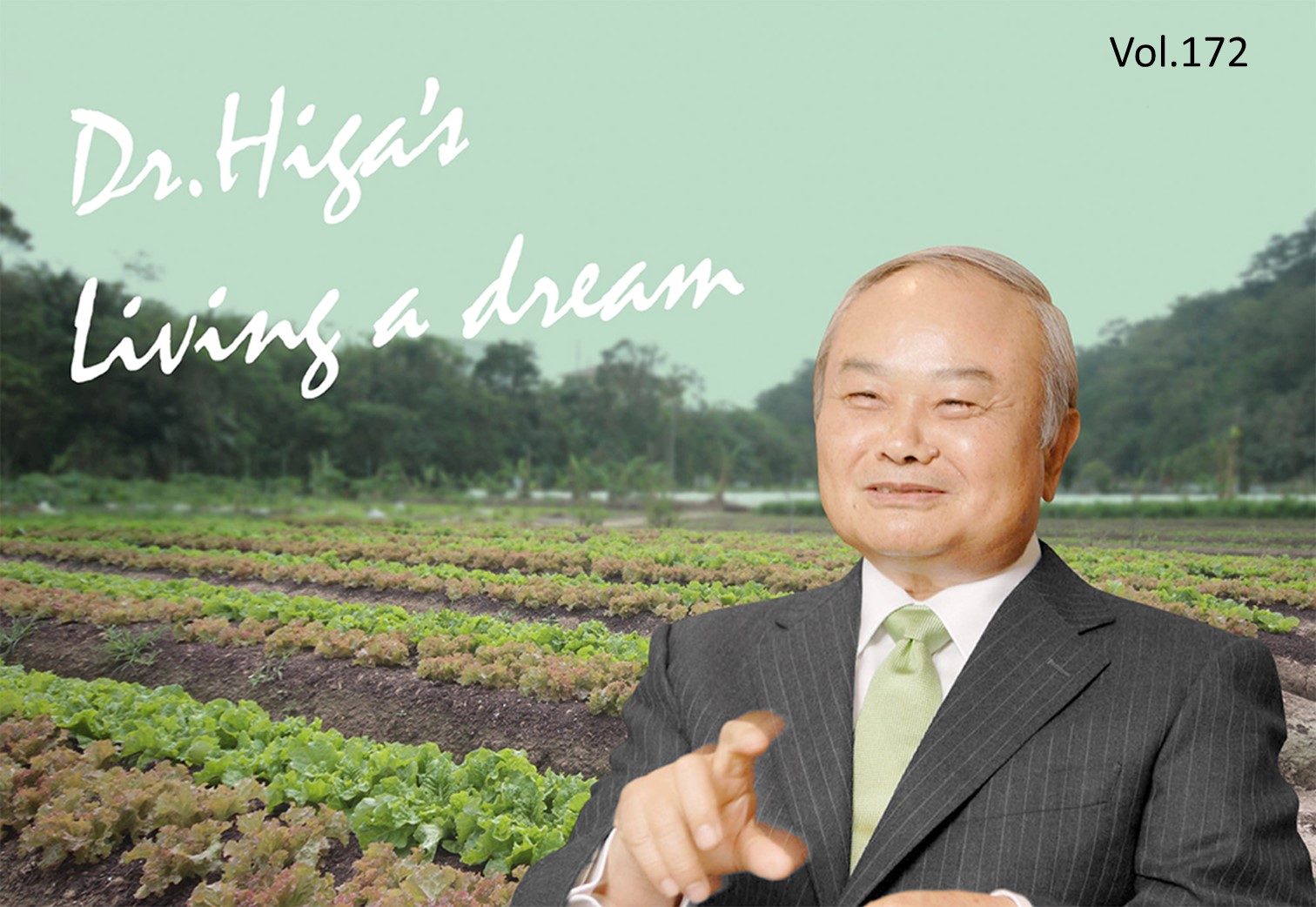
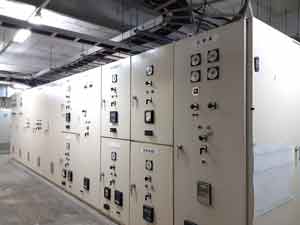
As I have discussed numerous times, since November 2013 the electrons flowing back from Hotel Costa Vista Okinawa (now EM Wellness Kurashi no Hakko Lifestyle Resort) and the EM-X GOLD manufacturing plant have become graviton-like and spread to the current network on the main island of Okinawa, and their effects have spread throughout the Ryukyu Islands.
(Reference: No. 158 “Plants in Okinawa made virus-free by EM Graviton barrier.”)
The results are clear to anyone. The first thing to note is that cars do not get dirty anymore when it rains. In other words, cars are clean without being washed, and in case they do get dirty, they will become clean again before long.
Second is that direct sun exposure, though hot, is not painful, and sunburns are extremely rare, so there are no first-aid cases of this kind. (This means that the sun’s ultraviolet rays are converted to infrared rays).
Additionally, exhaust gas is cleaned up quickly. In the past, if you stood on an overpass that straddled a highway, there was a terrible smell of exhaust gas, but now you can safely take a deep breath with no problems.
Every time it rains, dirt on buildings disappears, rust on signboards and road signs disappears, and the area is growing cleaner by the year.
There is also clear third-party data that shows that the area is less affected by electromagnetic waves, which increases work efficiency and is good for one’s health, contributing to the present Okinawa boom.
This is beyond the scope of data comparisons, so we are using this series of articles because it is necessary to gather facts and verify them over many years.
Continuing from last month’s article, I would like to introduce examples of stray birds and migratory birds this time as well. Conventional wisdom would say this is an exceptional phenomenon, but I believe it is the result of an improved environment. Birds are raising their young in peace, even in gardens everywhere.
The Deigo introduced in the latter part of this article used to have no flowers, or no attractive blooms at all, due to a parasitic insect infestation that spread throughout Okinawa. However, as a result of significantly raising the EM barrier level as a measure against the corona virus in hotels and factories starting in the spring of 2019, we see an impact throughout the Ryukyu Islands. Plants, especially bulbs, perennial plants and fruits, etc., are now flowering and bearing fruits in abundance, as if they were different varieties. I will introduce some examples in the next article.
(The following articles are provided by the Okinawa Times. All rights reserved.)
------------------------------
(Reference: No. 158 “Plants in Okinawa made virus-free by EM Graviton barrier.”)
The results are clear to anyone. The first thing to note is that cars do not get dirty anymore when it rains. In other words, cars are clean without being washed, and in case they do get dirty, they will become clean again before long.
Second is that direct sun exposure, though hot, is not painful, and sunburns are extremely rare, so there are no first-aid cases of this kind. (This means that the sun’s ultraviolet rays are converted to infrared rays).
Additionally, exhaust gas is cleaned up quickly. In the past, if you stood on an overpass that straddled a highway, there was a terrible smell of exhaust gas, but now you can safely take a deep breath with no problems.
Every time it rains, dirt on buildings disappears, rust on signboards and road signs disappears, and the area is growing cleaner by the year.
There is also clear third-party data that shows that the area is less affected by electromagnetic waves, which increases work efficiency and is good for one’s health, contributing to the present Okinawa boom.
This is beyond the scope of data comparisons, so we are using this series of articles because it is necessary to gather facts and verify them over many years.
Continuing from last month’s article, I would like to introduce examples of stray birds and migratory birds this time as well. Conventional wisdom would say this is an exceptional phenomenon, but I believe it is the result of an improved environment. Birds are raising their young in peace, even in gardens everywhere.
The Deigo introduced in the latter part of this article used to have no flowers, or no attractive blooms at all, due to a parasitic insect infestation that spread throughout Okinawa. However, as a result of significantly raising the EM barrier level as a measure against the corona virus in hotels and factories starting in the spring of 2019, we see an impact throughout the Ryukyu Islands. Plants, especially bulbs, perennial plants and fruits, etc., are now flowering and bearing fruits in abundance, as if they were different varieties. I will introduce some examples in the next article.
(The following articles are provided by the Okinawa Times. All rights reserved.)
------------------------------
Winter Birds take a break at Kunigami
A Pied avocet (right), with a distinctive upturned beak, and a black headed gull (left) were seen one by one in the rice fields in Kunigami Village on the 11th. Kazuya Kishimoto (32), a resident of Nago City, took these photos. Both birds can be observed in Okinawa in small numbers, and it is rare to be able to photograph them all at once.Mr. Kishimoto enjoys bird watching on his days off. As he was driving along in search of wild birds that morning, he noticed a bird with a black and white pattern on its body. “It’s a Pied avocet!” he thought, and hurriedly held his camera and enthusiastically snapped the shutter. After taking the pictures, he drove on a little further, still excited, and spotted a black headed gull in the distance. Mr. Kishimoto, said, smiling, that “I had never seen either of them before. I often come here, but the birds I see are different depending on the season and weather, so each time I visit it’s exciting.”
Yutaka Watakuchi, the manager of the Yagaji National Wildlife Sanctuary, noted that, “Both birds are winter birds and I think they stopped by on their way back to the north. Black-headed gulls, which are mainly observed on the coast, are rarely seen inland in Okinawa.”
(Kenta Kinjo, Reporter for the Northern News Department)
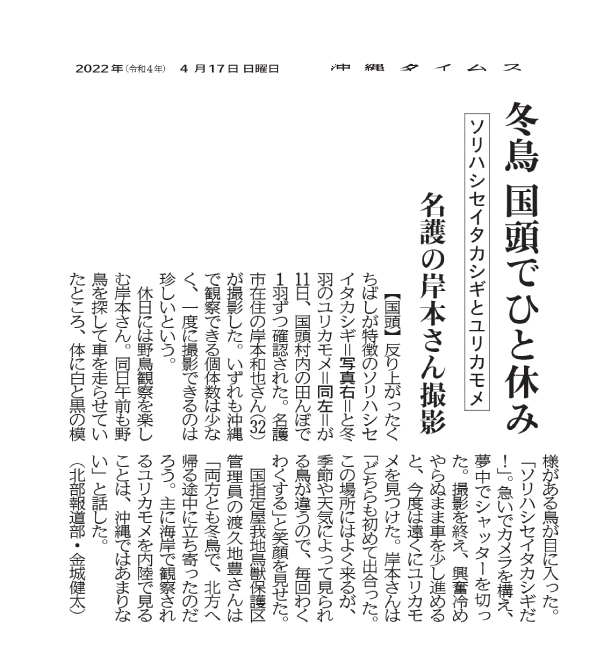
Okinawa Times, Sunday, April 17, 2022
A Pied avocet and a black-headed gull
Photo by Mr. Kishimoto, Nago
(provided by Okinawa Times)
------------------------------
A Rare Bird Flew to Itoman
Kamenobu Oshiro, an expert on wild birds, discovered the bird on the 8th, and Mr. Kozo Hashimoto (71), a member of the Southern Nature Conservation Society, photographed it on the 12th. The birds’ habitats include India, southern China and Southeast Asia.Masakuni Yamashito, chairman of the Okinawa Wild Bird Society, was happy with the news. “There are records of observation on Yonaguni Island and other Islands,” he noted, “but it is very rare on the main Island. They must have gotten lost for some reason.” Mr. Hashimoto said, “After searching for five days in a row, I was finally able to take a satisfactory picture. I was lucky that the bird happened to fly near me.”
Lesser Coucal are two-toned bird with a black head and tail feathers and brown wings. They are a popular bird among bird watchers.
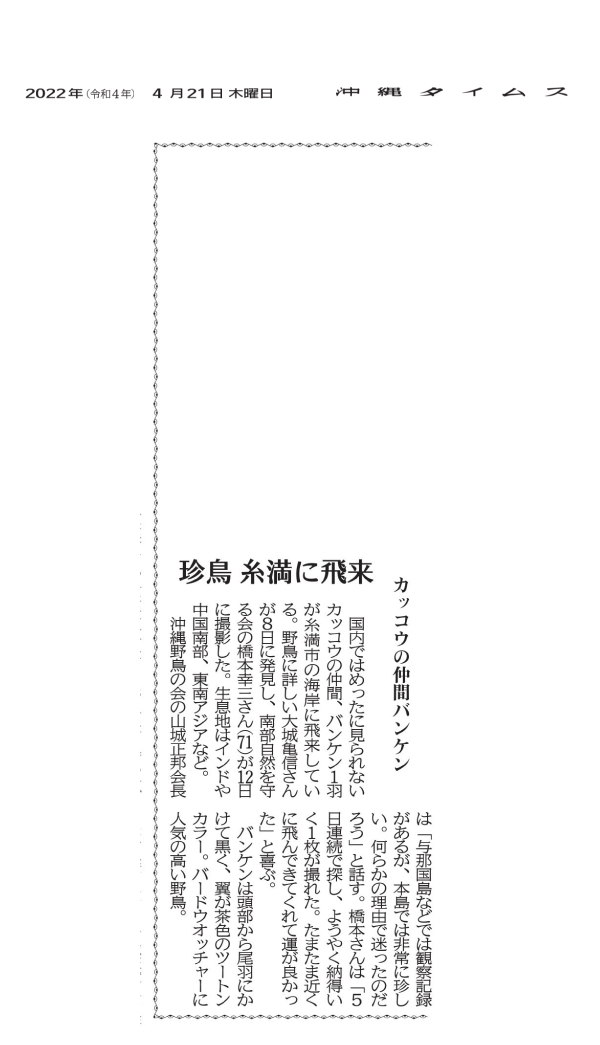
Okinawa Times, Thursday, April 21, 2022
Lesser Coucal, a species of cuckoo in the family Cuculidae.
A single Lesser Coucal, rarely seen in Japan, has been spotted flying to the coast of Itoman City.
(provided by Okinawa Times)
------------------------------
Citrine Wagtail in Ishigaki Island
On the 6th it was confirmed that a stray bird, a Citrine wagtail, which is rarely observed in Japan, was seen flying to farmland in Ishigaki City, Okinawa Prefecture. Mr. Masahiro Kobayashi (47), a field guide in Ishigaki Island, owner of “Sea Beans,” spotted the bird and photographed it. A small number of them fly to the prefecture in winter and sometimes overwinter here but is very rare to see their summer plumage. Mr. Kobayashi said, “This is my first time to observe it. From head to belly they are a very vivid yellow.”Citrine Wagtails breed in Central Asia and China and overwinter in Vietnam and India. Japan is far from their usual migration course.
(Daisuke Fukumoto, Editorial board member)
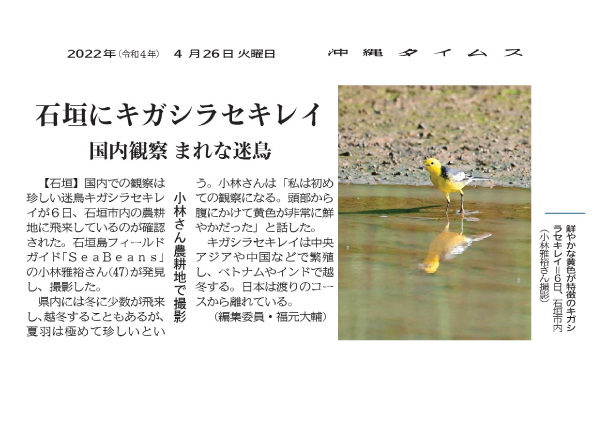
Okinawa Times, Tuesday, April 26, 2022
A stray lost bird observed in Japan
Photographed by Mr. Kobayashi on farmland
(provided by Okinawa Times)
------------------------------
A rare blue-green bird was observed
Second case of a Collared Kingfisher
During the spring migration season, a series of stray and rare birds which are rarely observed in the prefecture have been arriving at Ishigaki Island one after another. Perhaps lost in the middle of its trip, it was seen resting its feathers in the precious mangrove forest. A bird lover was delighted, saying, “I was crazy about photographing it.” It was discovered and photographed by Mr. Masahiro Kobayashi (47) of “Sea Beans”, a field guide service in Ishigaki Island. Bird Week will start on the 10th. (Editorial board member, Daisuke Fukumoto)
In Japan, a single Collared Kingfisher, which is a member of the kingfisher family rarely observed in the Nansei Islands, was found to have flown to Nagura Ampal in the western part of Ishigaki Island in February. It is a very rare bird that has only been sighted once in the past on Ishigaki Island. Mr. Kobayashi waited until the 7th of May to announce the find, when it was unlikely that the bird would be on the island.
This is the second sighting of the bird on Ishigaki Island, since two birds were recorded in 1975, and there are records of the bird flying to Miyako Island in 2002, Iriomote Island in 2005 and 2009, and Tomigusuku City in 2017, among others.
On February 2nd, when Mr. Kobayashi was looking for wild birds at the Ramsar Convention-listed wetland Nagura Ampal, he found a bird perched on the respiratory root of a Yaeyama Hirugi tree in a mangrove forest.
“I was so surprised to see the bird there,” he said, “since it was exactly the kind of composition I had hoped to encounter one day at this spot. I was more than 50 meters away from the bird, but was so excited that I went ahead and took the picture,” he said.
The bird is about 25 centimeters long and is found in India, Southeast Asia, and other parts of the world. It is popular among bird lovers because of its bright blue-green head, back and wings.
A Collared Kingfisher fly that flew to the mangrove in Nagura Ampal
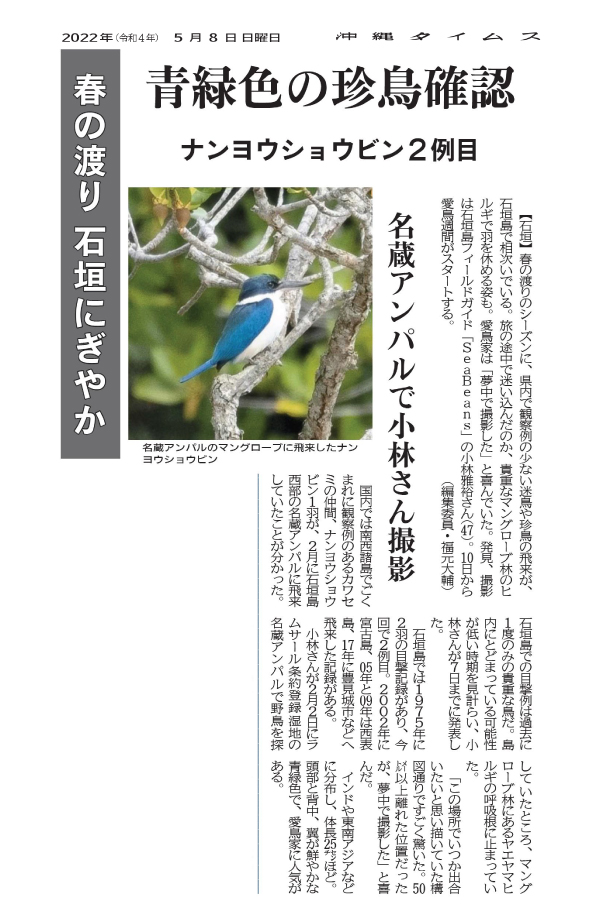
Okinawa Times, Sunday, May 8, 2022
Spring Migration Enlivens Ishigaki
Photographed by Mr. Kobayashi at Nagura Ampal
(provided by Okinawa Times)
------------------------------
Spectacular photograph of a rare bird in vivid summer plumage
A flock of Chinese pond heron
Shingo Hata, 16, a second-year student in the environmental department of Hentona High School, found and photographed about 10 Chinese pond heron in Kunigami Village on January 1st. These birds are rarely seen in a flock in their summer plumage in Okinawa. (Kenta Kinjo, Northern News Section)
Mr. Hata, a second-year student at Hentona High School, in Kunigami Village
On April 30th, Mr. Hata, who had decided to spend a long holiday weekend “observing the creatures I love,” woke up before dawn and drove around Yanbaru in the car driven by his father, Kazunobu. Around 7:30am, he spotted a flock of brightly colored wild birds, and through the binoculars from the car, he saw that they were reddish brown from head to neck, with blueish gray backs. They were Chinese pond herons. Although he held up the camera, he was too far away that day to take a good picture.
Determined to succeed, the next day he found the flock again at the same time and in the same area as the day before. “They were still there. This is my chance!” he thought, and this time he was able to take a wonderful photograph.
Yutaka Tokuchi, manager of the nationally designated Yagai Wild life Sanctuary, said, “In Okinawa, a small number of these birds usually arrive around autumn. It is rare to see a flock with their summer feathers.”
Shingo says that he became a fan of wild birds when he saw the parents and children of Okinawa rail when he a fifth grader in elementary school. “I don’t mind getting up early at all,” he said. His dream is to “find wild birds all over the world.”
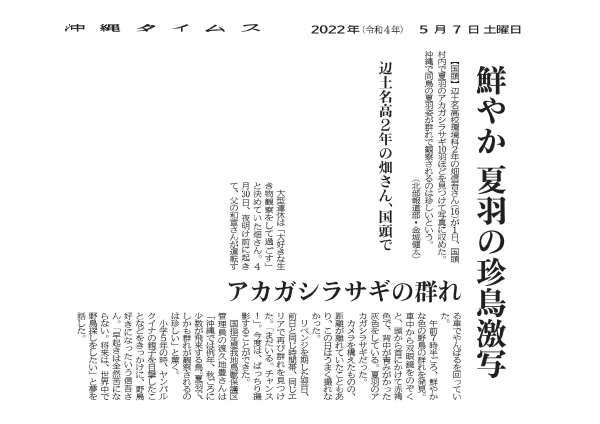
Okinawa Times, Saturday, May 7, 2022
(provided by Okinawa Times)
------------------------------
Bird Week starts today
Bird Week started on May 10th. All over the prefecture wild birds can be seen busily raising their young. On the balcony of the home of Mr. Akira Maeda, 73, in Tsuboya, Naha City, a Ryukyu bulbul has nested in a potted Shikwasa, a Citrus depressa, and is raising three chicks.His wife, Yoshiko, 68, says, “I secretly take pictures of them with my cell phone every day and record their growth. I’ve names all of them, too.” Last year, one bird left the nest in the same tree. Akira wonders why they chose a small potted plant when there are big trees in a nearby park.
Mr. and Mrs. Maeda could not forget the memories of the little bird and hoped that it would come back, and on April 11th, it flew in and began building a nest.
The chicks will leave the nest in about ten days. Yoshiko said, “I’m enjoying having them and am encouraged by the little birds. It’s sad to think they’ll be leaving soon.”
Parent birds of the Ryukyu bulbul feeding their chicks in the nest, Tsuboya, Naha City, on August 8th. (Photo by Hiroya Shimoji)
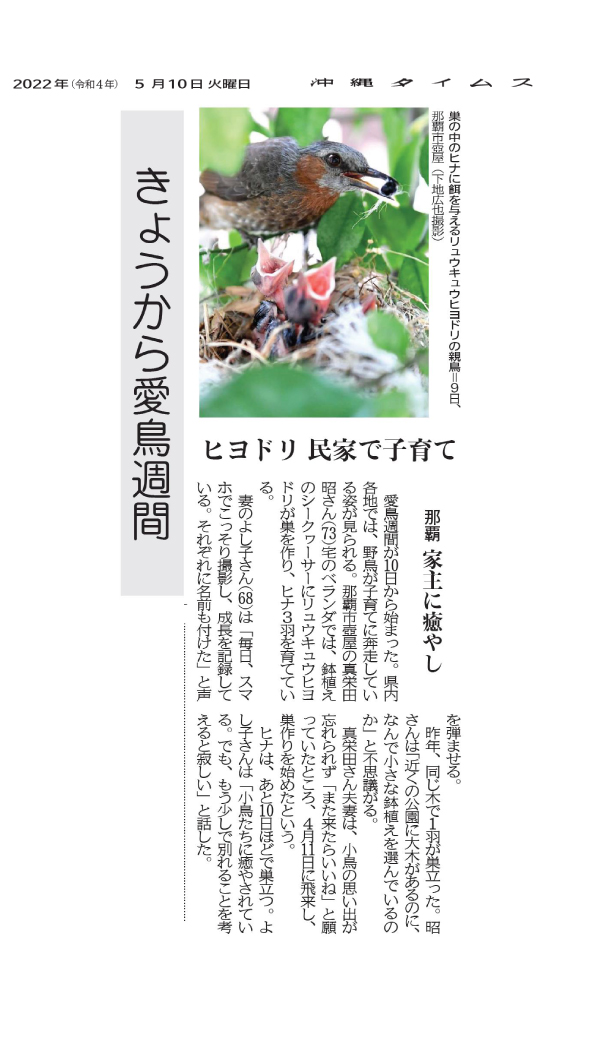
Okinawa Times, Tuesday, May 10, 2022
Ryukyu bulbul raise their young at a private home
Comforting the homeowner in Naha
(provided by Okinawa Times)
------------------------------
Deigo Flowers Color Early Summer
Crimson Flowers Glisten on Ogimi Miyagi Island
About seventy percent of the Deigo (Fabaceae), which have bright red flowers, are blossoming along National Highway No. 58 on Miyagi Island. These flowers have become a poetic feature of Miyagi Island, adding color to early summer. The tree is approximately 5 meters tall with branches spreading out 15 meters, and is said to have been planted with cuttings in 1983. It is a deciduous tree, and when the leaves fall, its bright red flowers stand out against the blue sky. (Reported by Manabu Tamaki)
Deigo (Fabaceae), which bloom bright red flowers along National Highway No. 58 on Miyagi Island, has bloomed for about seventy percent. It has become a poetic feature (tradition) of Miyagi Island, adding color to early summer. The tree is approximately 5 meters tall with 15 meter-wide branches, and it is said that it was planted with cuttings in 1983. It is a deciduous tree, and when the leaves fall, its bright red flowers stand out against the blue sky.
(Reported by Manabu Tamaki)
Deigo (Fabaceae), which bloom bright red flowers along National Highway No. 58 on Miyagi Island, has bloomed for about seventy percent. It has become a poetic feature (tradition) of Miyagi Island, adding color to early summer. The tree is approximately 5 meters tall with 15 meter-wide branches, and it is said that it was planted with cuttings in 1983. It is a deciduous tree, and when the leaves fall, its bright red flowers stand out against the blue sky.
(Reported by Manabu Tamaki)
Deigo blooms for about seventy percent and the area is colored with bright red flowers on April 14th, Miyagi Island in Ogimi Village
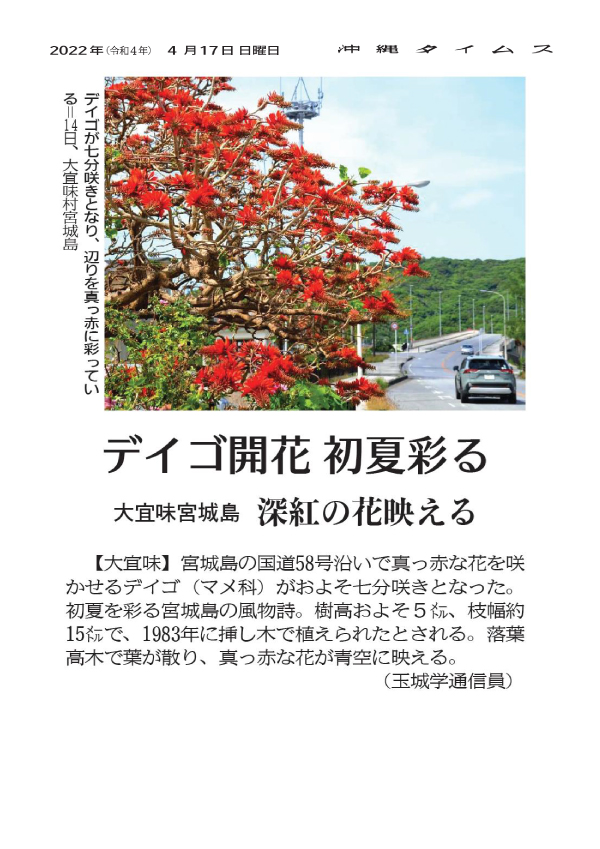
Deigo flowers are about seventy percent in bloom, adding a bright red color to the area.
April 14th, Miyagi Island in Ogimi Village.
Okinawa Times, Sunday, April 17, 2022
(provided by Okinawa Times)
------------------------------
Enjoy the brightly colored local flowers
200 Amaryllis flowers at Ms. Ohmine’s garden in Uruma
Amaryllis are in full bloom, red and pink flowers and other colors, and Ms. Omine happily commented that, “The number of flowers has increased since I replanted bulbs. They have been blooming beautifully recently, and I love looking at them while chatting with my friends.” Whenever she has time, Ms. Omine uses pruning shears to trim her trees and fruit trees. She becomes so absorbed in her work that she loses track of time, and the flowers and fruit trees in her garden are all neatly pruned and trimmed.
(Reported by Tokuzo Yokota)
Photo: About 200 amaryllis are blooming in and around the garden of Yoshiko Omine, 81, in Kawasaki, Uruma City.
(provided by Okinawa Times)
------------------------------
A Profusion of Petrea
Enjoying the sunshine in early summer
Mr. Nishidaira’s house in Uruma City
Petrea flowers are in full bloom at the house of Mr. Asanobu Nishidaira, 77, in Midori Town, Uruma City. The trunk is about 23 centimeters in circumference and the branches extend about 10 meters, and it seems that it is enjoying the urizun, the early summer season, as it descends in a tuft and the flowers bloom. Mr. Nishidaira’s wife, Nobuko, 77, said, “We bought a seedling about 30 centimeters tall six years ago at a nursery in Okinawa City. It has been blooming beautifully for the past two or three years and neighbors and people driving nearby seem interested in it.” She added, “I gave the seedlings to ten people last year and plan to give them to another ten people again this year.” Yasuko Kureya, 78, of Akano-ku, who passed by on January 12th, said, “They are so beautiful. I wrote down my name and gave them my phone number so I can get a seedling around October.”(Reported by Tokuzo Yokota)
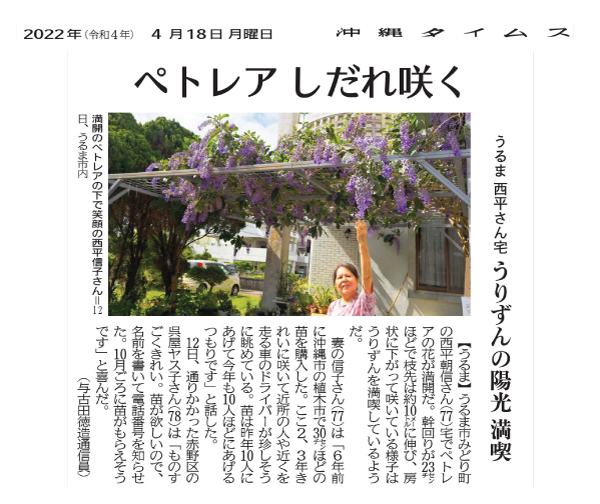
Okinawa Times, Tuesday, May 10, 2022
Photo: Nobuko Nishidaira smiling under the petrea in full bloom, in Uruma City on April 12th.
(provided by Okinawa Times)
------------------------------
700 Easter Lily flowers in full bloom
Residents in Nago take great care of the lilies
Approximately 700 Easter Lilies planted in February are now in full bloom at Isagawa Park in Isagawa-ku (headed by Tomoaki Taira), Nago City, delighting the eyes of passersby. For the past three years, Masakiyo Nakazato (72), Hayao Gibo (83) and others have planted the Easter Lilies along the tennis courts in the park with the help of the local women’s association and the senior citizens’ association.The flowers were carefully cared for, and Mr. Taira expressed his hope that the corona pandemic will soon be under control and that many people will be able to take a walk in the large sports field.
(Reported by Shoji Yamashiro)
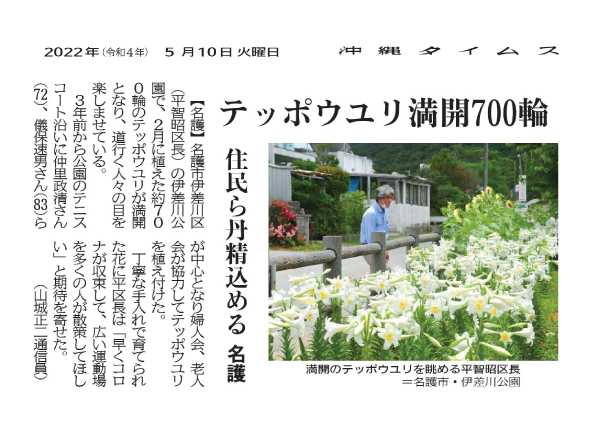
Okinawa Times, Tuesday, May 10, 2022
Photo: Tomoaki Taira, head of the ward, enjoying the Easter lilies in full bloom at Isagawa Park, Nago City.
(provided by Okinawa Times)
------------------------------
(May 25, 2022)
Editor’s Picks
-

#196 The Steadily Evolving EM Nature Farming Method at the Blue Sky Palace - Part 6 -

#195 The Steadily Evolving EM Nature Farming Method at the Blue Sky Palace - Part 5 -

#191 Steadily Evolving EM Nature Farming Method at the Blue Sky Palace -

#190 Quantum Mechanical Effects of EM Gravitron Charcoal
- 2025
- Apr:#204 How EM Use Has Spread Throughout the Philippines
- Mar:#203 How to Use EM to Fundamentally Solve the Problem of Agricultural Residue Burning
- Feb:#202 The Spread of EM technology in Germany
- Jan:#201 The 2nd Ichiro Masaki Memorial Universal Village EM International Conference
- Jan:#200 Cleanup of the Ala Wai Canal in Hawaii, where social bonds are strengthened using EM
- 2024
- Nov:#199 EM trials in India with bananas, tomatoes, and pomegranates
- Oct:#198 The Steadily Evolving EM Nature Farming Method at the Blue Sky Palace - Part 8
- Sep:#197 The Steadily Evolving EM Nature Farming Method at the Blue Sky Palace - Part 7
- Aug:#196 The Steadily Evolving EM Nature Farming Method at the Blue Sky Palace - Part 6
- Jul:#195 The Steadily Evolving EM Nature Farming Method at the Blue Sky Palace - Part 5
- Jun:#194 Steadily Evolving EM Nature Farming Method at the Blue Sky Palace - Part 4
- May:#193 Steadily Evolving EM Nature Farming Method at the Blue Sky Palace - Part 3
- May:#192 Steadily Evolving EM Nature Farming Method at the Blue Sky Palace - Part 2
- Apr:#191 Steadily Evolving EM Nature Farming Method at the Blue Sky Palace
- Mar:#190 Quantum Mechanical Effects of EM Gravitron Charcoal
- Mar:#189 The barrier space in Okinawa (Ryukyu Islands) has risen to another dimension
- Jan:#188 Sixty Days after Typhoon No.6
- 2023
- Oct:#187 Supermassive Typhoon No.6 and Subsequent Typhoon No. 11
- Sep:#186 Massive Typhoon No.6 that swallowed the Ryukyu Islands Graviton barrier
- Sep:#185 August 8th is World “EM Mudball Day”
- Aug:#184 A disease-free life depends on the health of the intestinal microbiome.
- Jul:#183 Trial and Error at the Blue-Sky Palace, Part 3
- Jun:#182 Trial and Error at the Blue-Sky Palace, Part 2
- Apr:#181 Trial and Error at the Blue-Sky Palace
- Mar:#180 Ala Wai Canal Cleanup Project in Waikiki, Hawaii
- Feb:#179 High-Yield, High-Quality Rice Production Using EM
- Feb:#178 The Progress the "Soil Preparation Workshop" of the Oishi 3-chan Club (Part 2)
- Jan:#177 Organic Farming Instructional Manual Using EM
- 2022
- Nov:#176 The Typhoon Situation in Okinawa in 2022
- Sep:#175 Third-Party Verification of the Graviton barrier in Okinawa Part-2
- Sep:#174 Third-Party Verification of the Graviton barrier in Okinawa
- Aug:#173 Ecosystem Changes Observed in Okinawa in 2021 Part-5
- Jun:#172 Ecosystem Changes Observed in Okinawa in 2021 Part-4
- May:#171 Ecosystem Changes Observed in Okinawa in 2021 Part-3
- Apr:#170 Ecosystem Changes Observed in Okinawa in 2021 Part-2
- Mar:#169 Koizumi Farm in Kamakura Continues to Evolve
- Feb:#168 Ecosystem Changes Observed in Okinawa in 2021 Part-1
- 2021
- Dec:#167 Enjoying EM Technology While Enriching the Local Ecosystem
- Nov:#166 A Case Study of the Use of EM in a Next Generation Free School in Tune with the Cycles of Nature
- Oct:#165 Typhoon conditions and flowers in Okinawa from August to October
- Sep:#164 Re-learning the origins of river purification using EM Cleaning up the Dairyuji River in Senami (Murakami City, Niigata Prefecture)
- Aug:#163 Measures Against Natural Disasters and Re-learning the Starting Point of EM
- Jul:#162 Summary of FFC (Foods for Children) Okinawa Forum 2021
- Jun:#161 Restoring the Vigor of an Old Tree and Purifying the Environment with EM Technology That Even an Amateur Can Do
- May:#160 The Public is Beginning to Recognize the Use of EM Smokeless Carbonizers
- Apr:#159 EM Hado (EM Graviton) that exerts quantum superposition effect over time
- Mar:#158 Virus-free Okinawan Plants Through Use of an EM Graviton Barrier
- Jan:#157 Enjoyable Farming for Self-Sufficiency that Even Amateurs Can Do
- 2020
- Dec:#156 EM quantum energy effect occurring in Okinawa
- Nov:#155 Implementing EM graviton farming as a flood countermeasure for apple orchards
- Oct:#154 The Latest Book on the Practical Uses of EM "You Are the One Who Draws Out the Power of Microorganisms," by Chizuko Nomoto
- Sep:#153 Application of EM technology to long periods of rain, lack of sunshine, storms, heavy rains, etc.
- Aug:#152 EM application in Kitanakagusuku village plant waste recycling yard
- Jul:#151 Natural Disaster Countermeasures Using EM Technology: Part 2
- Jul:#150 Natural Disaster Countermeasures Using EM Technology
- May:#149 How to make your home and workplace an energy spot by living a complete EM lifestyle: creating the ultimate source of health and environmental purification
- Apr:#148 EM, Viruses and the Pandemic
- Apr:#147 New agriculture applying quantum mechanics Part 2
- Apr:#146 New agriculture applying quantum mechanics
- Apr:#145 Wonderful EM Miracle
- 2019
- Nov:#144 The movie “Revival II” and the reality of Fukushima
- Oct:#143 Boundary dome and foliar spraying of EM・X GOLD and EM 3
- Oct:#142 Kirakira (Sparkling) Summer Vegetable Festa in 2019
- Aug:#141 Excessive salt inevitably causes salt damage
- Jul:#140 Diverse applications of charcoal Part 3
- Jun:#139 Diverse applications of charcoal Part 2
- Jun:#138 Diverse applications of charcoal
- Jun:#137 Purification power of salt
- May:#136 The degree of soil contamination is a reflection of the microflora
- May:#135 Definitive use of EM barriers to deal with typhoons
- May:#134 Implementing authentic Nature Farming
- May:#133 How to enhance healthy Hado (wave energy) by EM
- May:#132 Eating Dirt (Soil)
- May:#131 Hado (Wave energy) involved in health
- May:#130 Reaffirming EM technology to realize the essence of agriculture
- May:#129 The 2nd EM Producer Networking Meeting
- Apr:#128 Understanding the application of seawater and salt in crop cultivation
- Apr:#127 Prevention of Disasters by EM Technology
- Mar:#126 Quantum overlay effective utilization of EM
- Jan:#125 EM Disaster Recovery Support Projects in 2017
- 2018
- 2017
- Aug:#121 Escape from conventional agricultural traps
- Jul:#120 Limitation and important caveats regarding utilization of salt
- Jun:#119 EM Technology to Break Through the Limits of Pesticide-Free Strawberries
- May:#118 Application of barriers using EM rectification force
- Apr:#117 The 1st EM Produce Growers' Networking Conference
- Mar:#116 Sumizo kun: The Ultimate Versatile Carbonization Equipment
- Feb:#115 How to make and use simple carbonized and rectified ash
- Jan:#114 Achievements of 2016
- 2016
- Dec:#113 Definitive Measures Against Typhoons
- Nov:#112 International Conference on Universal Village
- Oct:#111 90% of Your Body is Microbes
- Sep:#110 Disaster Countermeasures Using EM
- Aug:#109: Changes in the Natural Environment by EM Barrier Domes in Okinawa
- Jul:#108: Multi-purpose Utilization of Activated EM with Seawater and Salt
- Jun:#107: Marine Day, when EM Mudballs and Activated EM are Applied Throughout Japan
- May:#106: The Function of EM and Gravitational Waves–Part 3
- Apr:#105: The Function of EM and Gravitational Waves–Part 2
- Feb:#104: The Function of EM and Gravitational Waves
- Feb:#103: The Importance of Phototrophic Bacteria in EM
- 2015
- Dec:#102: Results of Environmental Forum "Utsukushima EM Paradise" 2015
- Nov:#101: Environmental Forum "Utsukushima EM Paradise" 2015
- Oct:#100: A New Phase of Limit Breakthrough Using EM
- Sep:#99: A New Phase of Limit Breakthrough through EM
- Aug:#98: The Tokyo Bay Area Began Creating a Truly Livable Hometown
- Jul:#97: Rectifying Effects of EM
- Jun:#96: Lake Suwa Sousei lecture
- May:#95: In Order to Further Ensure Limit Breakthrough
- Apr:#94: Theatrical Release of the Documentary Film SOSEI-Revival to Enlighten People on the New Possibilities of Microorganisms
- Mar:#93: What Underlies Limit Breakthrough (Part 2)
- Feb:#92: EM Functions to Break Through Limits
- Jan:#91: At the Start of 2015
- 2014
- Dec:#90: Looking Back at 2014
- Nov:#89: Shikoku EM FESTA 2014, Virtuous Circle Conference in Matsuyama, Ehime Prefecture
- Oct:#88: Using EM to Deal with Weather Disasters (Part 2)
- Sep:#87: Current Status of Radioactivity Measures Using EM in Fukushima
- Aug:#86: APNAN (Asia Pacific Natural Agriculture Network) 25th Anniversary Conference in 2014
- Jul:#85: Using EM to Deal with Weather Disasters
- Jun:#84: Substantial Improvement of Soil
- May:#83: The Energy Rectification Force of EM
- Apr:#82: The Annual 18th EM Technology Exchange Meeting and Tohoku Conference in Shichigahama
- Mar:#81: Salmon going upstream in Kitaura (Kasumigaura)
- Feb:#80: The Microbiome Again
- Jan:#79: Inauguration of the Federation of Diet Members Who Use and Apply Effective Microorganisms
- 2013
- Dec:#78: Receiving an Honorary Doctoral Degree from Rajamangala University of Technology in Thailand
- Nov:#77: The Use of EM in School Education in Bhutan
- Oct:#76: Well of Bonding
- Sep:#75: The Background to EM Not Being Employed by Public Institutions to Deal with Radiation
- Aug:#74: Dealing with Disaster: Using EM in Crisis Management
- Jul:#73: EM Events on Ocean Day
- Jun:#72: Using EM to Deal With Heat Stroke and Summer Heat Fatigue
- May:#71: An EM Model Town in Malaysia
- Apr:#70: Steps the Japanese Government is Taking to Deal with Radiation: Are They Really Safe?
- Mar:#69: EM Group Disaster Reconstruction Aid Project in Fukushima
- Feb:#68: EM and Microbiomes (Microbial Flora)
- Jan:#67: A Necessary Evil is Still Evil
- 2012
- Dec:#66: The 17th National EM Technology Exchange Conference / Hokkaido Conference in Sapporo
- Nov:#65: EM Forum 2012 in Okinawa and the Environmental Forum in Fukushima
- Oct:#64: 2012 EM Forum
- Sep:#63: A New Earth Saving Revolution
- Aug:#62: The Asahi Newspaper’s Misguided Reports About EM
- Jul:#61: Using EM in Radioactive Contamination Measures in Fukushima Prefecture
- Jun:#60: The Effects of Using EM to Inhibit the Absorption of Radioactivity as Confirmed in Fukushima
- May:#59: Recovery Support for the Great East Japan Earthquake
- Apr:#58: The Royal Kingdom of Thailand, in which EM Functions as a Set Government Policy
- Mar:#57: Report on the Measures Taken by Kingdom of Thailand Using EM to Deal with Polluted Water
- Feb:#56 EM™ as Part of National Policy in Thailand to Deal with Sanitation Issues Resulting from the Flood of 2011
- Jan:#55 The Law of Syntropy (Revitalization)
- 2011
- Dec:#54 EM Forum 2011
- Nov:#53 Shikoku EM Festa 2011- Zenjunkan no Wa (Virtuous Circle) Tokushima Conference in Naruto -
- Oct:#52 The Mystery of Interim Safety Values for Radioactive Material
- Sep:#51 Successful Radiation Countermeasures Using EM
- Aug:#50 Events on Sea Day in which EM Mud Balls are Thrown into the Water and Activated EM is Applied.
- May:#47 Dealing with the Damage Caused by the Eastern Japan Earthquake
- Apr:#46 Eastern Japan Earthquake
- Mar:#45 The 16th National EM Technology Hokuriku Conference in Fukui
- Feb:#44 More Thoughts on Avian Influenza and Foot-and-Mouth Disease
- Jan:#43 Happy New Year!
- 2010
- Dec:#42 Shikoku EM FESTA 2010・Zenjunkan no wa (Virtuous Circle) Fellowship Conference in Tobe, Ehime Prefecture
- Nov:#41 EM Forum 2010
- Oct:#40: My Thanks to the EM™ Volunteers Who Helped in the Fight Against Foot-and-Mouth Disease in Miyazaki Prefecture
- Sep:#39 International EM Mud Ball Day
- Jul:#37 Poland EM Forum 2010
- Jun:#36 EM Countermeasures Against Foot-and-Mouth Disease
- May:#35 Abnormal Weather
- Apr:#34 EM Activities in Thailand: Finding Solutions to the Challenges Facing the Nation
- Mar:#33 New Developments in the Evolution of EMTM in Thailand
- Feb:#32 Results Starting to Be Seen at the Mikasa Project
- Jan:#31 Towards an EM-Use Society
- 2009
- Dec:#30 EM Summit
- Nov:#29 The System in Penang State in Malaysia that Made the World EMTM Mudball Day a Success
- Oct:#28 The "World EM Mudball Day" in Malaysia
- Sep:#27 Validating EMTM Medicine: Case Study Reports from EM Users 2009. (Part 3)
- Sep:#26 Validating EMTM Medicine: Case Study Reports from EMTM Users 2009. (Part 2)
- Jul:#25 Validating EMTM Medicine: Case Study Reports from EMTM Users 2009. (Part 1)
- Jun:#24 Activities to Disseminate EM-Focused Nature Farming in China
- May:#23 Use of EMTM in Response to Swine Flu
- Apr:#22 Using EM to Solve Public Administrative Costs
- Mar:#21 Reaffirming the Versatility of EM
- Jan:#20 The Beginning of a New Era
- 2008
